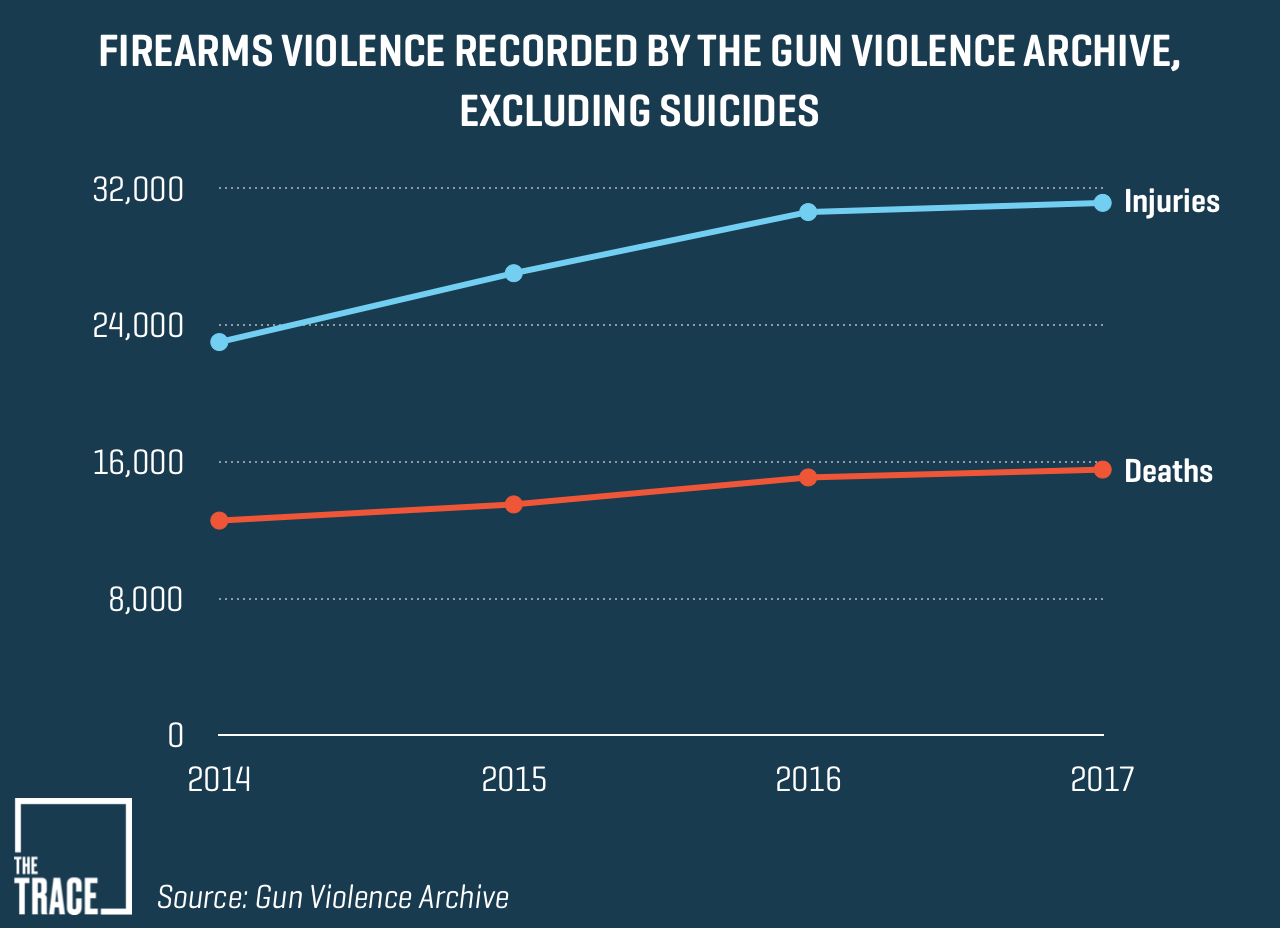Update: The CDC’s official tally of 2017 gun deaths has been released.
Excluding most suicides, at least 15,549 people were killed by guns in the United States in 2017, according to data collected by Gun Violence Archive (GVA), a nonprofit organization that tracks media and law enforcement reports of shootings.
Gun Violence Archive makes its data available in real time, and the figure represents the first available estimate of gun deaths in 2017. The Centers for Disease Control and Prevention and the FBI, which record firearm mortality and firearm homicides, respectively, typically take months to release year-end summaries of their data.
In December, the CDC published data showing 38,658 gun deaths for 2016, including suicides. The number of gun deaths recorded by CDC researchers has increased for two consecutive years.

The Gun Violence Archive count for 2017 marks a 3 percent increase over the previous year and offers an early indication that the recent rise in gun deaths recorded by federal agencies is continuing.
Here is our updated comparison of End Of Year totals of gun violence data in the U.S. from the past four years.
NOTE: We will publish another update on January 15th. pic.twitter.com/jlbK3iz14Q
— The Gun Violence Archive (@GunDeaths) January 8, 2018
Despite the speed of GVA’s data collection efforts, it is relatively accurate. In 2014 and 2015, the two years for which both CDC and GVA data are available, the agency and nonprofit’s tallies of non-suicide firearm deaths were within 5 percent of each other.
The exclusion of suicides from GVA’s count shouldn’t be construed as a suggestion that gun suicides don’t count toward the total of gun violence, as a National Rifle Association spokesman recently suggested. Studies have repeatedly shown a strong relationship between firearm access and suicide. Rather, GVA includes only a small fraction of suicides in its real-time count because they are more difficult to track than other forms of gun violence.
The organization also tallied 31,157 firearm injuries in 2017, a rise of nearly 2 percent over the previous year. Because nonfatal gun injuries are less likely to make the news than fatal ones, this may represent a significant undercount of the true number. In 2015, the most recent year for which CDC data is available, the agency recorded 85,000 firearm injuries.
While 2017 was marked by multiple high-profile mass shootings, including the massacres in Las Vegas and Sutherland Springs, Texas, the Archive’s year-end tally of mass shootings recorded a slight decrease, from 383 in 2016 to 344 in 2017. (Gun Violence Archive defines a mass shooting as any incident in which four or more people are injured or killed with a gun.)
The number of people killed in mass shootings also declined, from 456 to 433. As in previous years, fatalities from mass shootings continued to make up a small fraction of overall firearm deaths: less than 3 percent of the total.
Other takeaways from the numbers:
- 3,964 children and teenagers were shot in 2017, including fatal and nonfatal shootings. This is a lower count than the findings of a CDC study which reported that more than 6,400 children and teens were shot each year, excluding self-inflicted gunshots, from 2012 to 2014.
- Incidents of defensive gun use increased slightly, from 1,979 in 2016 to 2,030 in 2017. The majority of gun owners cite self-defense as their primary reason for owning a gun.
- Unintentional shootings dropped by 9 percent. Only four states have some form of law requiring gun owners to safely store their guns when not in use – a practice linked to lower rates of accidental shootings.
As of April 17, Gun Violence Archive has recorded 4,140 deaths and 7,298 injuries in 2018.
This article has been updated to reflect that a small number of suicide deaths are included in GVA’s real-time totals and to include final CDC estimates for firearms deaths in 2016.


